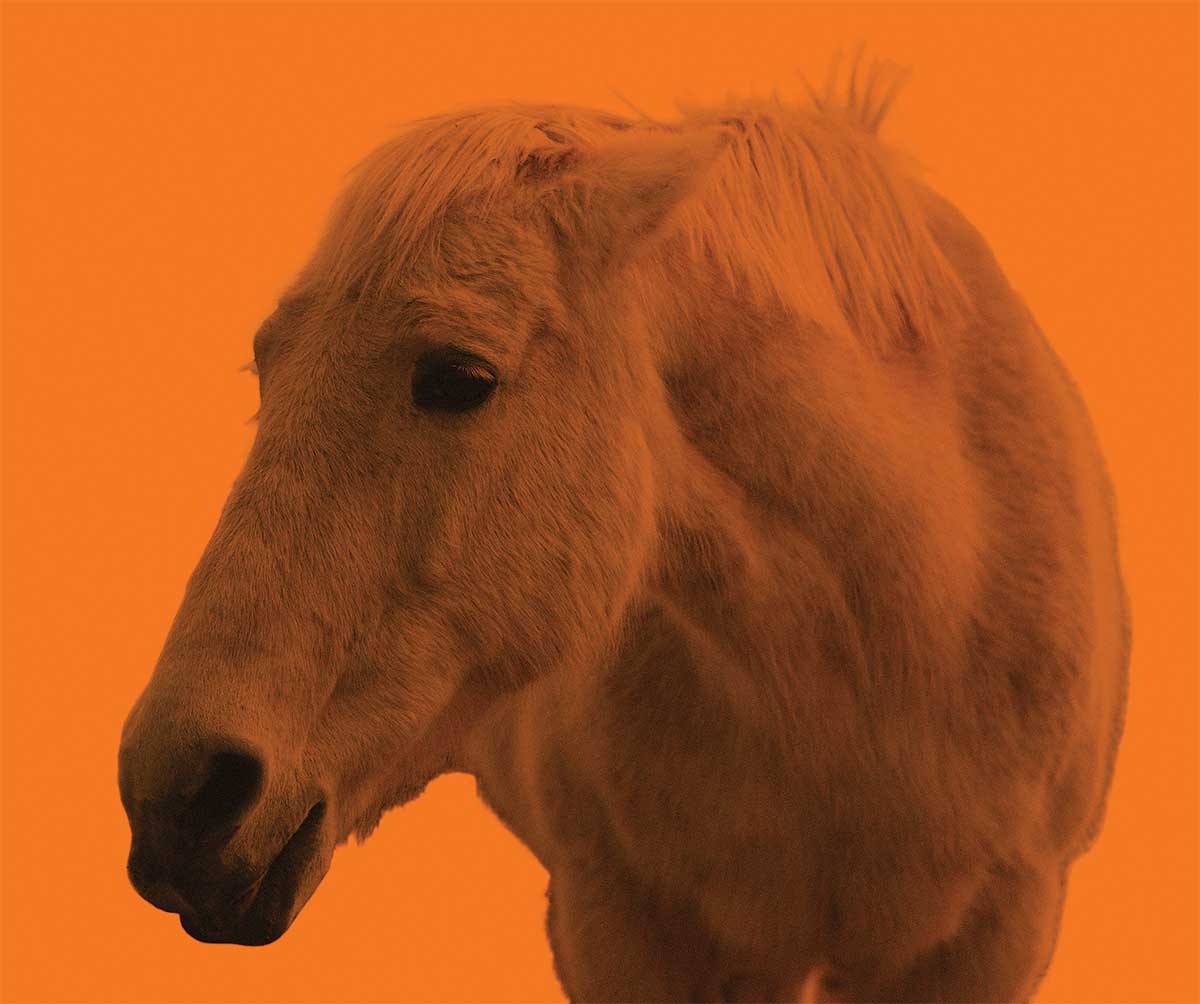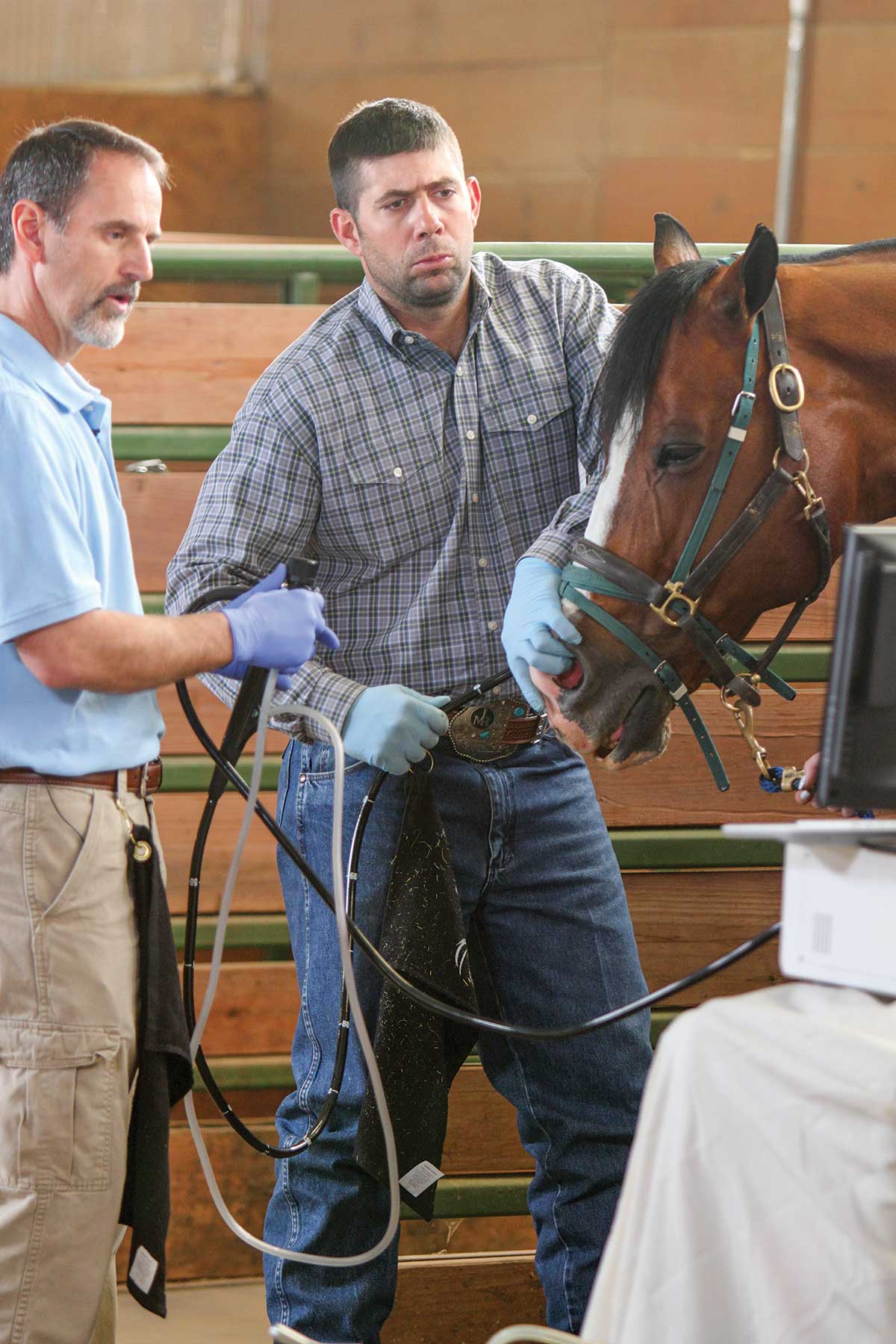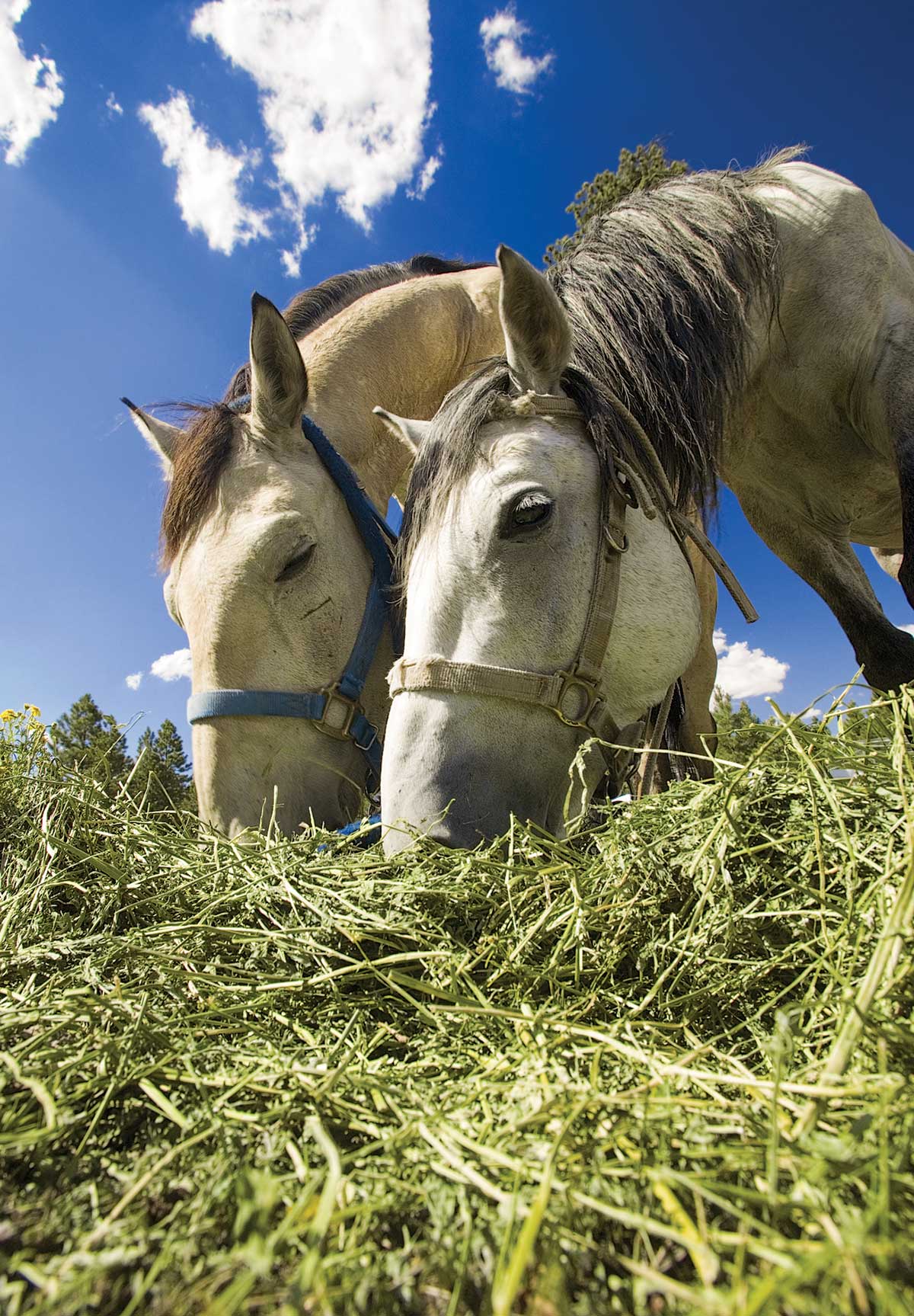
The client walks into my office with a defeated expression. “My horse is really crabby/resistant/unhappy…” she tells me. Before she even takes a breath, I finish the sentence for her… “and your farrier/trainer/friend told you he has ulcers.”
“Yes!” the client gasps, “how did you know?”
Because I hear it every day. Usually followed by the advice to order some kind of powder to magically solve her horse’s behavior problems once and for all.
Equine gastric ulcer syndrome (EGUS) is probably the most misunderstood, misdiagnosed, and mistreated condition in equine medicine. Which is interesting, really, because it’s one of the most straightforward conditions we diagnose and treat as equine veterinarians (although that’s now changing a bit-—see “The Great Divide,” page 82). In fact, we have the tools to easily make a specific diagnosis with a single test, have treatments with proven efficacy, and even have scientifically supported knowledge about steps we can take to prevent equine gastric ulcers.
Here I’ll tell you the truths behind the myths about this common condition. If you think your horse has ulcers, you’ll learn what to do and how to do it…the right way.
The Bad Attitude
Myth #1: My horse is girthy. He pins his ears and swishes his tail every time I tack him up. These symptoms mean he must have gastric ulcers, right?
Truth: Many people assume a horse has ulcers if he becomes girthy, grouchy, or difficult during training. Symptoms caused by ulcers are non-specific, meaning many different diseases can cause similar signs. If you assume your horse has ulcers and he doesn’t, not only will the treatment be ineffective, you could also overlook another, more serious problem in need of consideration.
The most common symptom of ulcers is intermittent colic, especially if your horse exhibits signs of pain immediately following a meal. He’s likely to have a decrease in appetite, be fussy about his meals, and may have overall poor condition. Surprisingly, studies show that although behavior changes and poor performance may be associated with ulcers, these signs aren’t consistent in all horses.
Nightmarish Poop
Myth #2: If my horse has ulcers he’ll have blood in his manure. There’s a simple test that can check for blood and make a diagnosis so I can begin treatment.
Truth: Gastric ulcers won’t cause blood in your horse’s manure. Hence testing for blood in your horse’s manure isn’t an accurate way to diagnose ulcers. The only way to definitively diagnose your horse with gastric ulcers is with an endoscopic examination of his stomach—called gastroscopy. For this test, your vet will pass a flexible tube outfitted with a tiny camera through your horse’s nose, down his esophagus, and into his stomach. If there are ulcers present, your vet will see them.
The test for blood in your horse’s manure (commonly called a fecal occult blood test) may be useful for other things (though this test produces a high incidence of false positive results, so must be interpreted carefully). A genuine positive on this test can raise a suspicion that your horse could have right dorsal colitis, an inflammatory condition of a specific portion of the large intestine. It can be associated with excessive use of anti-inflammatory medications such as phenylbutazone, and can cause small amounts of blood in the manure. Similar to ulcers, right dorsal colitis may cause a loss of appetite, weight loss, and intermittent colic symptoms. This makes it difficult to determine whether your horse has right dorsal colitis or gastric ulcers, based on clinical signs alone. To make things even harder, right dorsal colitis is challenging to definitively diagnose, making gastroscopy an important step for ruling out stomach ulcers if right dorsal colitis is suspected.
Finally, if you decide to have your horse’s manure tested, be sure he hasn’t recently had a rectal exam, commonly performed during a colic episode, which can lead to blood in the manure for up to 24 hours.

Hot Spots
Myth #3: My equine chiropractor told me my horse has gastric ulcers because he’s sensitive to stimulation of various “ulcer points” on his body.
Truth: While it’s true that sensitivity to specific points on your horse’s body can help pinpoint the source of problems, this sensitivity is often non-specific. Even highly trained and experienced acupuncture practitioners explain that reactivity to points associated with gastric ulcers can also be associated with other problems with the gastrointestinal tract, such as colitis (inflammation of the large intestine) or enteritis (inflammation of the small intestine). Detecting sensitivity to stimulation of ulcer points can provide useful information, but it’s not an accurate way to diagnose gastric ulcers. If your horse has other signs consistent with gastric ulcers, reactivity to acupuncture points might help you decide to schedule gastroscopy to make a definitive diagnosis. It’s a matter of taking in all the information to make an informed decision of what to look for.
The Great Divide: Squamous vs. Glandular
You may think all ulcers are created equal, but that’s not true. In fact, your horse’s stomach is divided into to two portions: the upper, squamous portion, by the entrance of the esophagus (called the cardia); and the lower, glandular portion, where food enters the small intestine through the opening called the pylorus. While we typically think of ulcers impacting the squamous portion of the stomach, we now know ulcers in the glandular or pyloric region can have much more serious consequences for your horse.
Squamous ulcers are common, relatively easy to identify, and typically respond well to medication and management changes. Glandular and pyloric ulcers can be harder to see and more difficult to treat. The distinction is important enough that these two disease processes have just recently been given different names. What we once referred to as equine gastric ulcer syndrome (EGUS) is now divided into equine squamous gastric ulcer syndrome (ESGUS) and equine glandular gastric ulcer syndrome (EGGUS).
This distinction makes gastroscopy even more important if you suspect your horse has ulcers—both for making an accurate diagnosis and for monitoring a response to treatment.
Diarrhea Is Key
Myth #4: My horse always gets diarrhea when he’s stressed. I’m sure that means he has ulcers.
Truth: You might be surprised to learn that diarrhea is rarely, if ever, a sign of gastric ulcers. The stomach is a long way away from the end of the gastrointestinal tract, so stomach problems are unlikely to impact the consistency of your horse’s manure. If your horse has diarrhea, it’s much more likely that he has a problem with his large intestine, which is farther down the intestinal tract.
Painful, Expensive Exam
Myth #5: I understand the only way to accurately diagnose gastric ulcers is to use an endoscope to look into my horse’s stomach. But this is an expensive and difficult test. I don’t have the cash, and I don’t want to put my horse through such a miserable experience.
Truth: In reality, gastroscopy is a simple and relatively painless procedure with little risk. To prepare for this diagnostic test, your horse will be held off food and water overnight. He’ll be lightly sedated to minimize stress, and the entire procedure typically lasts less than 15 minutes. Gastroscopy is a black-and-white test that immediately gives you an accurate, insightful diagnosis.
Expensive? The cost of gastroscopy is typically less than $500. That’s a fraction of the cost of treating ulcers with an effective medication (more on that later). Not only does it make financial sense to obtain an accurate diagnosis, it helps ensure that your horse will receive proper treatment and care.

I’m Pretty Sure I’m Right…
Myth #6: I was pretty sure my horse had ulcers, so I started him on ulcer medications and he got better. Obviously, he had them, so it makes more sense to just keep treating him than it does to spend the money on endoscopy.
Truth: Have you ever heard of the placebo effect? That’s a beneficial effect, produced by a placebo drug or treatment, that can’t be attributed to the properties of the placebo itself, and must therefore be due to the patient’s belief in that treatment. Believe it or not, studies have shown that the placebo effect is alive and well when it comes to owners and their horses. That’s right. If you think your horse is being treated with a medication targeting a specific disease, there’s a good chance you’ll also think your horse is getting better—even if he hasn’t received the medication at all. This is especially likely with a condition like gastric ulcers, where signs are vague, non-specific, and include things like poor performance or bad behavior. In other words, just because you think your horse seems better when getting ulcer medications doesn’t mean he is. You could be simply throwing your money away.
In addition, if your horse really does have ulcers it’s important to monitor not only the severity of his condition, but also his response to treatment. With gastroscopy, your vet can get a thorough look at your horse’s stomach to grade the severity of disease. Then, with a follow up gastroscopy after treatment, he can determine whether your horse responded well or if he needs additional treatment.
Finally, if you assume your horse has ulcers and he doesn’t, it’s possible he could be suffering from a different, even more serious problem. By failing to make an accurate diagnosis you could significantly impact his long-term health.
Experts Weigh In
Still not convinced? The European College of Equine Internal Medicine recently published a consensus statement on equine gastric ulcer syndrome in horses based on a review of all of the available scientific research. The review committee “does not support the practice of diagnosing EGUS based on ‘characteristic’ clinical signs, and recommends that EGUS be confirmed by performing gastroscopy.” They conclude that “gastroscopy is the only reliable antemortem (before death) method for definitively identifying gastric ulceration,” and state that “initiation of treatment without prior gastroscopy is discouraged.”
Buying ‘Generic’
Myth #7: Equine-labeled ulcer medications like GastroGard and UlcerGard are expensive. I can buy powdered omeprazole from a compounding pharmacy for a fraction of the price—and it’s exactly the same medication.
Truth: The most effective treatment currently available for treating ulcers is omeprazole, a medication that permanently impairs the pump that causes acid to be secreted into the stomach. Omeprazole is effective if administered just once a day, and once acid pumps are destroyed, new pumps must be made before acid production will resume. Omeprazole is destroyed by acids, and must be protected within the acidic environment of the stomach. In order for it to be effective, it must be formulated in a buffered paste or enteric-coated granule. Plain, unprotected powder (offered by a wide variety of compounding pharmacies) won’t work. At this time, the only effective omeprazole products available in the United States are GastroGard or UlcerGard. Omeprazole in buffered form will heal up to 80 percent of ulcers within 28 days of treatment.
In some cases, an additional medication called sucralfate, which coats and protects the stomach lining, may be used in conjunction with omeprazole for best results. Medications that block acid receptors such as cimetidine (Tagamet) and ranitidine (Zantac) can be effective, but unlike omeprazole these medications are dependent on maintaining constant blood levels and must be dosed at regular eight-hour intervals.
Finally, there are new treatments on the horizon, including a blend of polysaccharides that’s recently shown promise in helping to promote ulcer healing. It’s important to realize, however, that these treatments are not yet FDA-approved, nor have they withstood the test of time. If you decide to treat your horse with an alternative medication, gastroscopy before and after treatment becomes even more important in order to determine whether the treatment has been effective for your horse and the future course of action.
Alfalfa Is the Culprit
Myth #8: My friend insists on feeding her horse alfalfa hay, even though he was diagnosed with ulcers. If she just stopped feeding such a rich diet, I know he’d get better without all of those expensive medications.
Truth: Including alfalfa in the daily ration is actually recommended for horses diagnosed with ulcers, or as a means of preventing them from developing. The higher calcium content of alfalfa means it can have a buffering effect, which can help protect the stomach lining from acids. While alfalfa isn’t likely to have a negative effect, grain meals can. Continue feeding alfalfa, but discontinue or minimize grain as much as possible.
It’s true that feeding strategies can be an important part of treating and preventing ulcers. Because horses are grazing animals designed to eat continuously throughout the day, their digestive system functions by secreting acids 24 hours a day. (Unlike humans, where acid secretion is stimulated only at mealtime.) Continuous access to hay or pasture is best. If that’s not possible, frequent small meals (intervals no less than six hours apart) can help. Not only will the presence of feed in the stomach help protect its delicate lining, but continuous chewing means your horse produces a steady stream of saliva, which can have a buffering effect.
A recent study indicates that timing of feeding may also impact effectiveness of omeprazole treatment, and that it may be best to administer the medication first thing in the morning and wait 60 to 90 minutes before feeding hay.
Don’t Make a Blind Decision
What’s the bottom line? No matter what you hear, if you think your horse has gastric ulcers, the most important thing you can do is schedule a gastroscopy to make a definitive diagnosis. Only then can you come up with an effective treatment plan and monitor his healing progress to ensure his long-term health.






